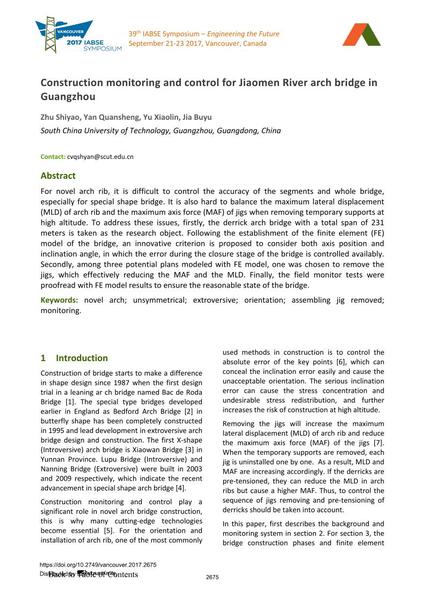Construction monitoring and control for Jiaomen River arch bridge in Guangzhou

|
|
|||||||||||
Détails bibliographiques
| Auteur(s): |
Shiyao Zhu
(South China University of Technology, Guangzhou, Guangdong, China)
Quansheng Yan (South China University of Technology, Guangzhou, Guangdong, China) Xiaolin Yu (South China University of Technology, Guangzhou, Guangdong, China) Buyu Jia (South China University of Technology, Guangzhou, Guangdong, China) |
||||
|---|---|---|---|---|---|
| Médium: | papier de conférence | ||||
| Langue(s): | anglais | ||||
| Conférence: | IABSE Symposium: Engineering the Future, Vancouver, Canada, 21-23 September 2017 | ||||
| Publié dans: | IABSE Symposium Vancouver 2017 | ||||
|
|||||
| Page(s): | 2675-2682 | ||||
| Nombre total de pages (du PDF): | 8 | ||||
| Année: | 2017 | ||||
| DOI: | 10.2749/vancouver.2017.2675 | ||||
| Abstrait: |
For novel arch rib, it is difficult to control the accuracy of the segments and whole bridge, especially for special shape bridge. It is also hard to balance the maximum lateral displacement (MLD) of arch rib and the maximum axis force (MAF) of jigs when removing temporary supports at high altitude. To address these issues, firstly, the derrick arch bridge with a total span of 231 meters is taken as the research object. Following the establishment of the finite element (FE) model of the bridge, an innovative criterion is proposed to consider both axis position and inclination angle, in which the error during the closure stage of the bridge is controlled availably. Secondly, among three potential plans modeled with FE model, one was chosen to remove the jigs, which effectively reducing the MAF and the MLD. Finally, the field monitor tests were proofread with FE model results to ensure the reasonable state of the bridge. |
||||
